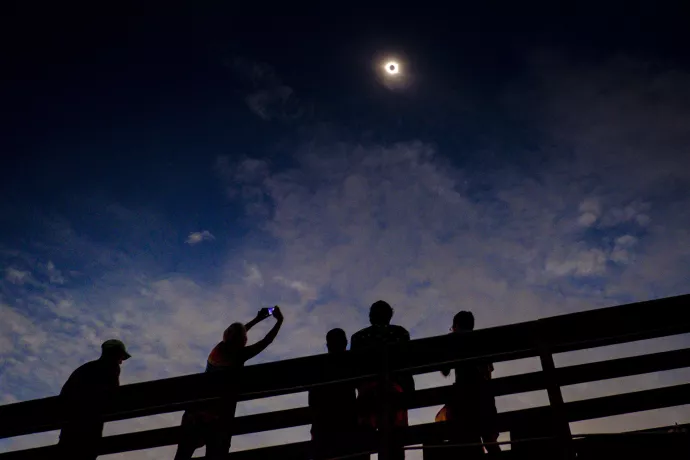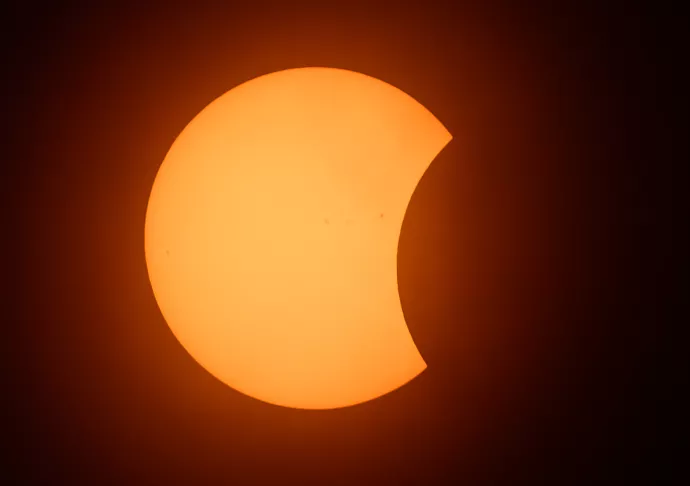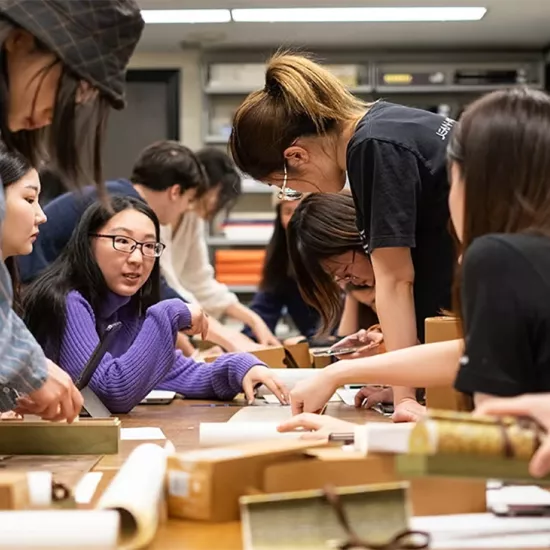UTM to mark rare solar eclipse with public on-campus viewing party

On Monday, April 8, residents of southern Ontario will witness one of nature’s grandest spectacles — a solar eclipse. From the southern part of the Golden Horseshoe, from Hamilton to Niagara Falls, the eclipse will be total, with the sun completely covered by the moon for a few brief minutes. From Mississauga, it will be a very deep partial eclipse; at its peak, the moon will cover 99.6 per cent of the sun’s disk, leaving only the thinnest sliver of sunlight.
“This is a once-in-a-lifetime event,” says University of Toronto Mississauga astronomer Marta Bryan, who’s organizing a special afternoon centred on the eclipse at the university’s Mississauga campus. “It will be a really inspiring event for people to experience in person,” she says.
Bryan says the UTM campus eclipse festivities, now sold out, will run from 1:30 p.m. to 4:30 p.m. outside the William G. Davis Building. Solar eclipse viewers (also known as eclipse glasses) will be available for registered guests to allow people to observe the eclipse safely. There will also be public lectures (including one delivered by Bryan herself) at the event hosted by the department of chemical and physical sciences and UTM alumni relations.
Please note that due to overwhelming response, the event has reached capacity and registration for this event is now closed.

Undergrad and graduate student scientists will be on hand to answer questions about the eclipse and to point out related astronomical phenomena — like the planet Venus, for example, which ought to become visible as the sky darkens in the minutes leading up to maximum eclipse.
From Mississauga, the partial eclipse will begin at 2:04 p.m., when the moon will appear to take its first “bite” out of the sun, and continue until 4:31 p.m. Maximum eclipse will come just after 3:19 p.m., when all but a tiny fraction of the sun’s disk will be obscured by the moon.
Only eclipse glasses are recommended for viewing the sun directly. But the spectacle can be viewed indirectly, by projecting the sun’s image using a piece of cardboard with a hole punched in it, and a sheet of white paper. Event organizers will be following eye safety procedures recommended by NASA.
While everyone is hoping for clear skies on the big day, even if it’s cloudy, it should be a memorable event, with the sky becoming eerily dark in the middle of the afternoon.
Bryan specializes in the study of planetary formation and evolution, and was recently awarded the Annie Jump Cannon award for her work on exoplanets (planets that orbit stars beyond our solar system). She sees this April’s eclipse as a unique opportunity to mix science and outreach.
“It’s a chance to advertise the astronomy program and community to a broader audience,” says Bryan, who joined UTM’s department of chemical and physical sciences in 2023 with a cross-appointment to the David A. Dunlap Institute of astronomy and astrophysics. She says the festival should be of particular interest to those in the local Mississauga community, who may not be able to travel great distances on the day of the eclipse.

Among the mini science lessons that she hopes people will take away from the event: The sun is about 400 times larger than the moon; however, it’s also 400 times further from Earth. As a result, the two objects appear roughly the same size in our sky. This in turn means that when eclipses occur, the total phase of the eclipse is always very brief, as the moon only just barely covers the sun.
Bryan notes that various changes can be observed on the ground as well as in the sky. For example, animals and even plants are known to respond to the reduction in sunlight during an eclipse — though not necessarily in the same way they would at sunset, she says.
This will be Bryan’s second total (or nearly total) eclipse, as she caught the eclipse of Aug. 21, 2017, from central Oregon, where she was living at the time. The problem that day was not clouds but rather smoke from nearby wildfires, she recalls. “It was a little bit touch and go,” she says. “The day before the eclipse, the smoke was so thick that you couldn’t see the houses across the street.” On the day of the eclipse she drove into the foothills of the Cascade Mountains, getting above most of the smoke, for an unobstructed view.
For those who can travel, a total solar eclipse can be seen from somewhere on Earth’s surface several times per decade. But for viewers in southern Ontario, the next eclipse as deep as the April 8 event won’t happen for another 120 years, until the total eclipse of October 26, 2144.
U of T events for April 8, 2024 solar eclipse:
Hosted by UTM chemical & physical sciences and UTM Alumni
Hosted by Dunlap Institute for Astronomy & Astrophysics
From U of T Scarborough astrophysicist professor Hanno Rein



